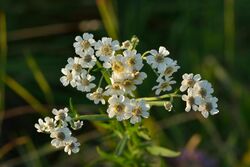Biology:Achillea ptarmica
| Sneezewort | |
|---|---|

| |
| Scientific classification | |
| Kingdom: | Plantae |
| Clade: | Tracheophytes |
| Clade: | Angiosperms |
| Clade: | Eudicots |
| Clade: | Asterids |
| Order: | Asterales |
| Family: | Asteraceae |
| Genus: | Achillea |
| Species: | A. ptarmica
|
| Binomial name | |
| Achillea ptarmica | |
| Synonyms[1] | |
|
Synonymy
| |
Achillea ptarmica is a European species of herbaceous perennial flowering plant in the genus Achillea of the daisy family Asteraceae. Common names include the sneezewort, sneezeweed, bastard pellitory, European pellitory, fair-maid-of-France, goose tongue, sneezewort yarrow, wild pellitory, and white tansy.[2] It is widespread across most of Europe and naturalized in scattered places in North America.[3][4][5][6] It is native to Europe and western Asia.[7]
Achillea ptarmica has loose clusters of showy white composite flower heads that bloom from June to August. Its dark green leaves have finely toothed margins. Like many other plants, the sneezewort's pattern of development displays the Fibonacci sequence.[8]
The name ptarmica comes from the Greek word ptairo (=sneeze) and means 'causes sneezing'.
Uses
Leaves can be eaten raw or cooked. Achillea ptarmica yields an essential oil that is used in herbal medicine. The leaves are used as an insect repellent.[9][10]
When chewed, the plant produces a numbing, tingling effect in the mouth, comparable to that of Sichuan pepper. For this reason, it is sometimes used in herbal medicine to relieve toothache or ulcers, and as a culinary herb.[11][12]
Cultivation
This is a hardy, drought-tolerant plant that prefers full sun and moist but well-drained soil. Propagation is by sowing seed or division in Spring.[13][14] It will tolerate hot, humid summers, and drought.[7]
References
| Wikimedia Commons has media related to Achillea ptarmica. |
- ↑ The Plant List, Achillea ptarmica L.
- ↑ "Achillea ptarmica (ACHPT)". EPPO Global Database. https://gd.eppo.int/taxon/ACHPT. Retrieved 30 August 2020.
- ↑ Altervista Flora Italiana, Millefoglio palustre, Sneezewort, Achillea ptarmica L. includes photos and European distribution map
- ↑ Flora of North America Vol. 19, 20 and 21 Page 494 Sneezeweed, sneezewort, achillée ptarmique, herbe-à-éternuer Achillea ptarmica Linnaeus, Sp. Pl. 2: 898. 1753.
- ↑ Biota of North America Program 2014 county distribution map
- ↑ The IUCN Red List of Threatened Species
- ↑ 7.0 7.1 "Achillea ptarmica (The Pearl Group) - Plant Finder". https://www.missouribotanicalgarden.org/PlantFinder/PlantFinderDetails.aspx?taxonid=261946.
- ↑ Jill Britton (7 May 2005). "Fibonacci Numbers in Nature". Archived from the original on 5 September 2016. https://web.archive.org/web/20160905160202/http://britton.disted.camosun.bc.ca/fibslide/jbfibslide.htm.
- ↑ "Temperate Plants Database, Achillea ptarmica". 2020. http://temperate.theferns.info/plant/Achillea+ptarmica.
- ↑ "Plants for a Future, Achillea ptarmica". 2005. http://pfaf.org/user/Plant.aspx?LatinName=Achillea%20ptarmicaa.
- ↑ "Wild Spices of the UK – Galloway Wild Foods". https://gallowaywildfoods.com/wild-spices-of-the-uk/.
- ↑ "SNEEZEWORT: Overview, Uses, Side Effects, Precautions, Interactions, Dosing and Reviews". https://www.webmd.com/vitamins/ai/ingredientmono-199/sneezewort.
- ↑ Bailey, L. H. (2005). Manual of Gardening (Second ed.). Project Gutenberg Literary Archive Foundation. https://www.gutenberg.org/ebooks/9550.
- ↑ Wood, John (2006). Hardy Perennials and Old Fashioned Flowers. Project Gutenberg Literary Archive Foundation.
Wikidata ☰ Q1335122 entry
 |

